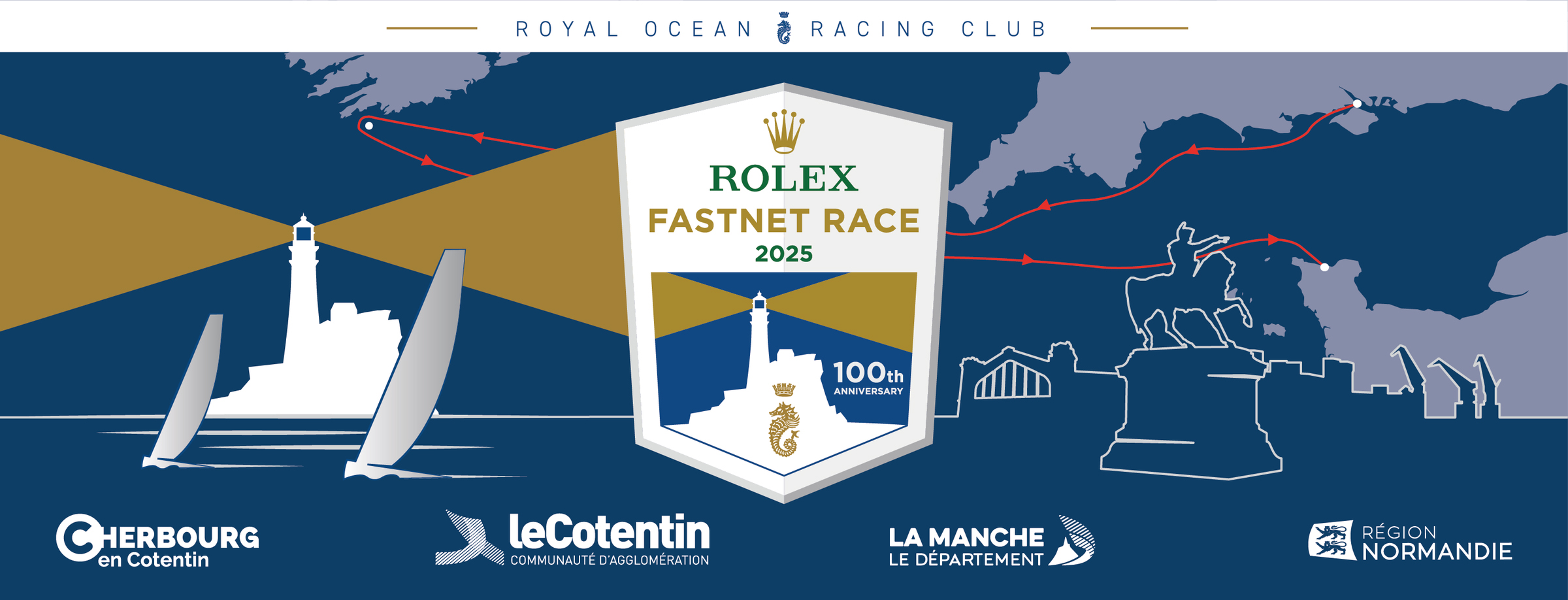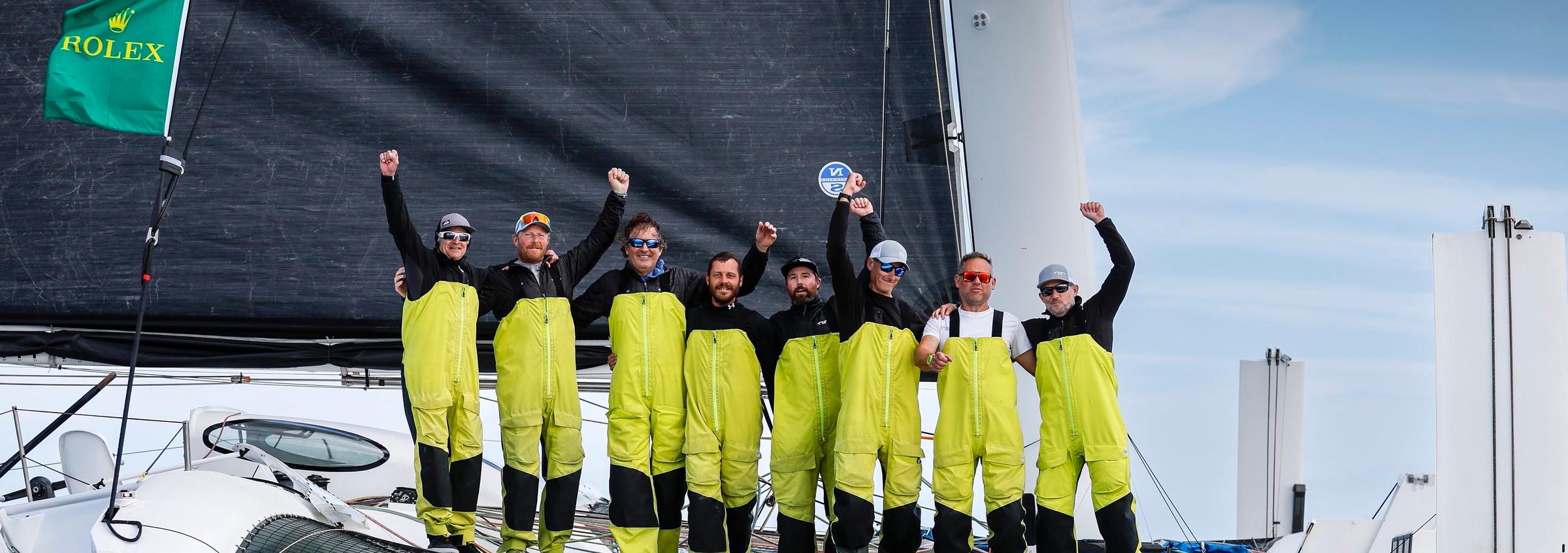

01:00 Tuesday 29 July 2025
Past experience had shown that one of the most competitive races in this centenary Rolex Fastnet Race would be the dust-up between the former MOD70 trimarans, now no longer one-design but with an especially updated foil package and other…mods.
What perhaps no one predicted is that after all the multihulls – including the MODs, the Ultims and Ocean Fifty trimarans, and the rest of the MOCRA catamaran and trimaran fleet – set off from Cowes at the same time, it would be the 70ft MODs that would lead the entire 444 boat Rolex Fastnet Race fleet, including the giant 32m (105ft) long Ultim trimarans out into the Channel. While Jason Carroll’s Argo had this privilege, the Ultims inevitably powered past, flying upwind. Subsequently Erik Maris’ Zoulou took the lead after diving into Lyme Bay more dramatically than her rivals.
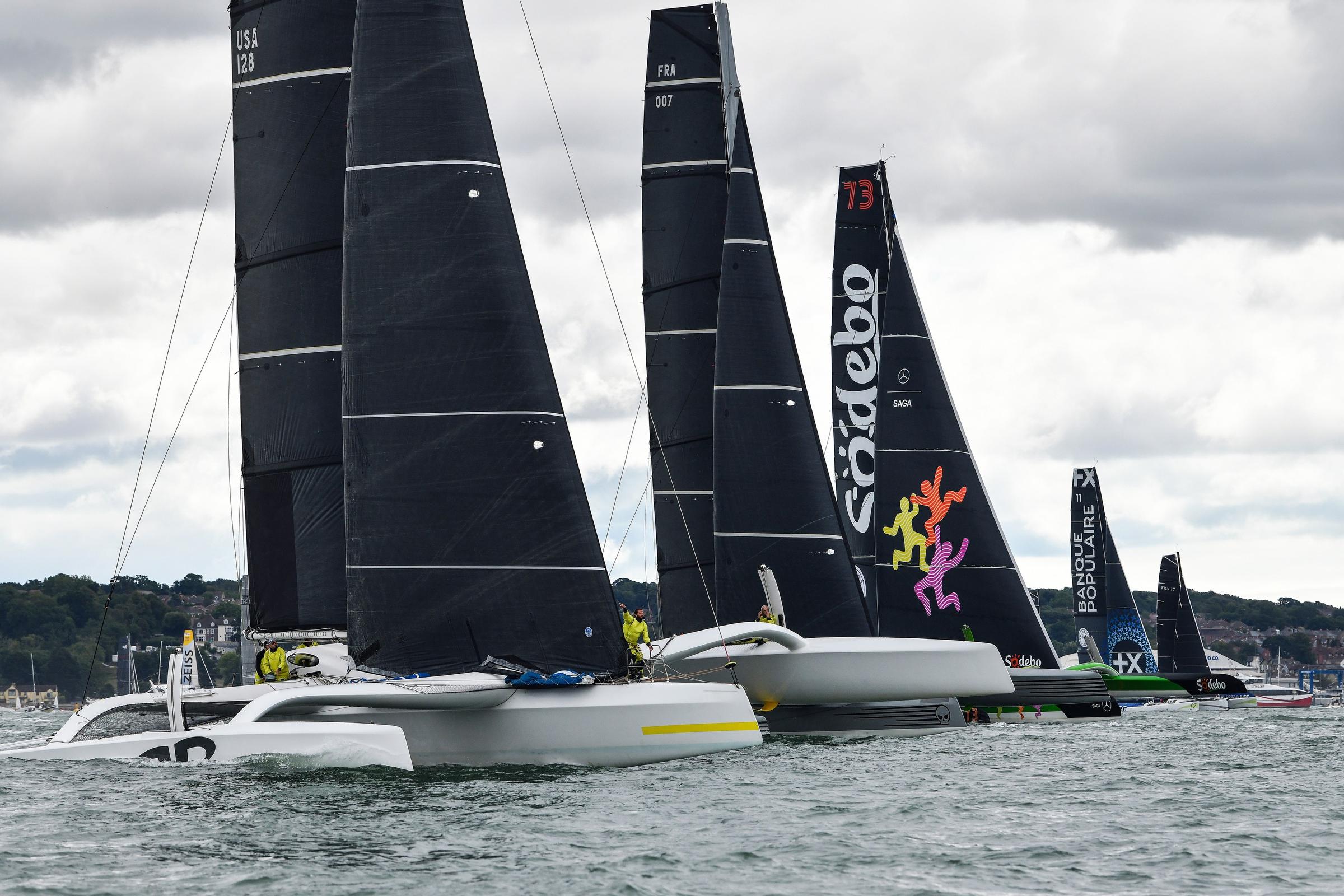 Jason Carroll's Argo may have started alongside the 32m Ultims but the MOD70 was still able to lead the entire multihull fleet out of the Solent © James Tomlinson/RORC
Jason Carroll's Argo may have started alongside the 32m Ultims but the MOD70 was still able to lead the entire multihull fleet out of the Solent © James Tomlinson/RORC
As Argo’s project manager Chad Corning explained: “We should have followed them more closely into Lyme Bay. The new wind came in, they got to it first and then just reached out to a 5-6 mile advantage and they were able to kind of escape.”
While the Ultims subsequently once again performed a ‘horizon job’, Zoulou led Argo across the Irish Sea, making better work of the lighter conditions before closing on the County Cork coastline where they tacked west. “The rich got a little bit richer after they got the hop on us there,” continued Corning. “If there's wind, the MODs are very comfortable and really a pleasure to sail. The tough part is that in sub-five knots it is really a struggle and it was very shifty in that light patch – maybe 10 hours before we got to Fastnet. So that was tough sledding for sure.”
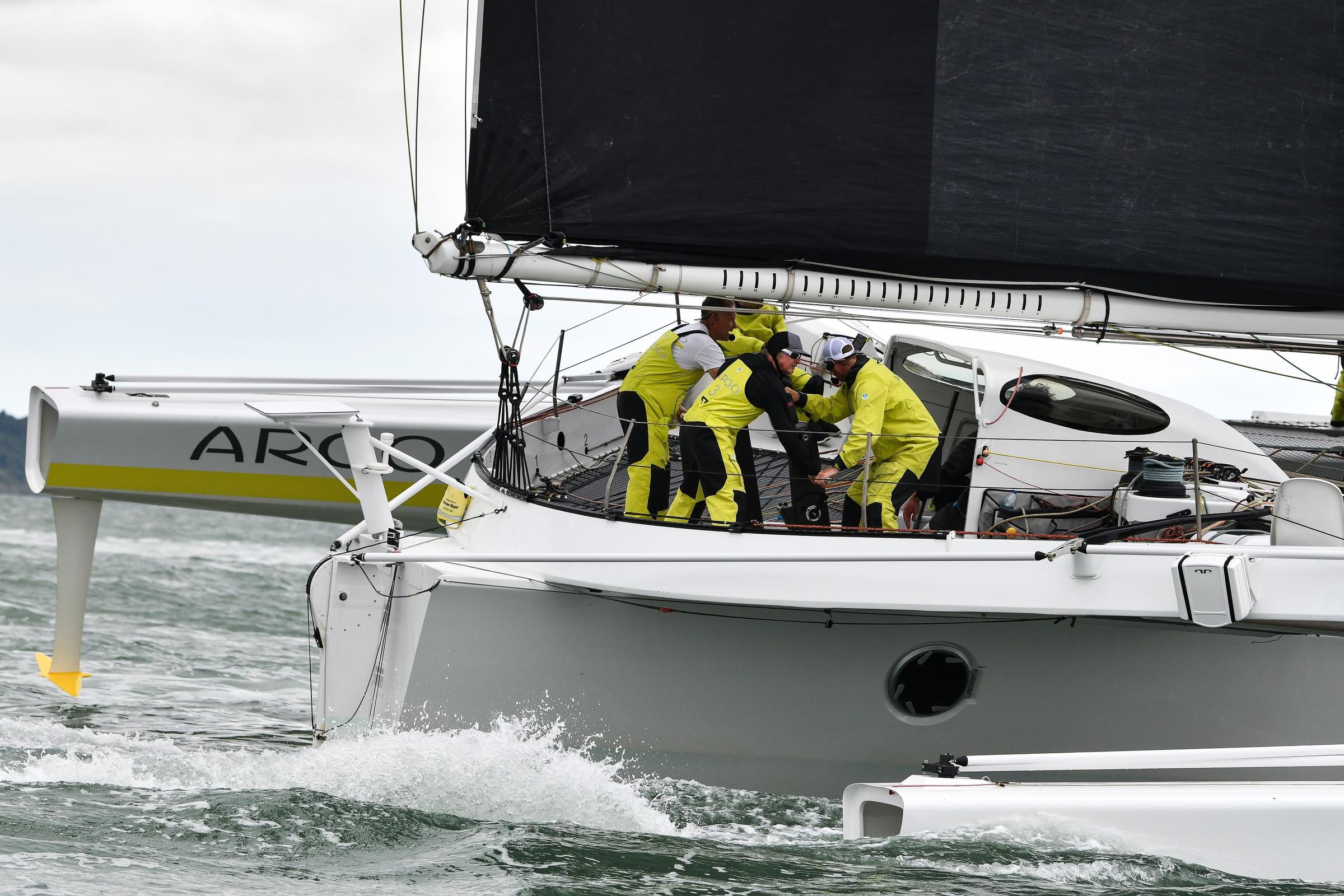 The crew grinding hard on board Argo at the start in Cowes © James Tomlinson/RORC
The crew grinding hard on board Argo at the start in Cowes © James Tomlinson/RORC
Zoulou rounded the Rock at 19:00 on Sunday 27 July, followed by Argo around 25 minutes later. Rounding first enabled Zoulou to crack sheets first, building speed and thereby further gaining. “Once they got to Fastnet and bore away and started ripping, all of a sudden their seven-mile lead was 17 miles as we rounded. So we definitely had a lot of work to do.”
Making speeds into the mid-20s, both put in a gybe east to start with, the two ultimately splitting at the TSS south of the Scilly Isles, where Argo took the northerly route and Zoulou the south.
Here Argo enjoyed some of the best sailing of the race. “You had to gybe quite a bit to stay in the best pressure, but there was a really good pressure,” said Corning. “So the boat was high 20s, low 30s, a lot of the time in pretty smooth water. So it was quite enjoyable sailing.”
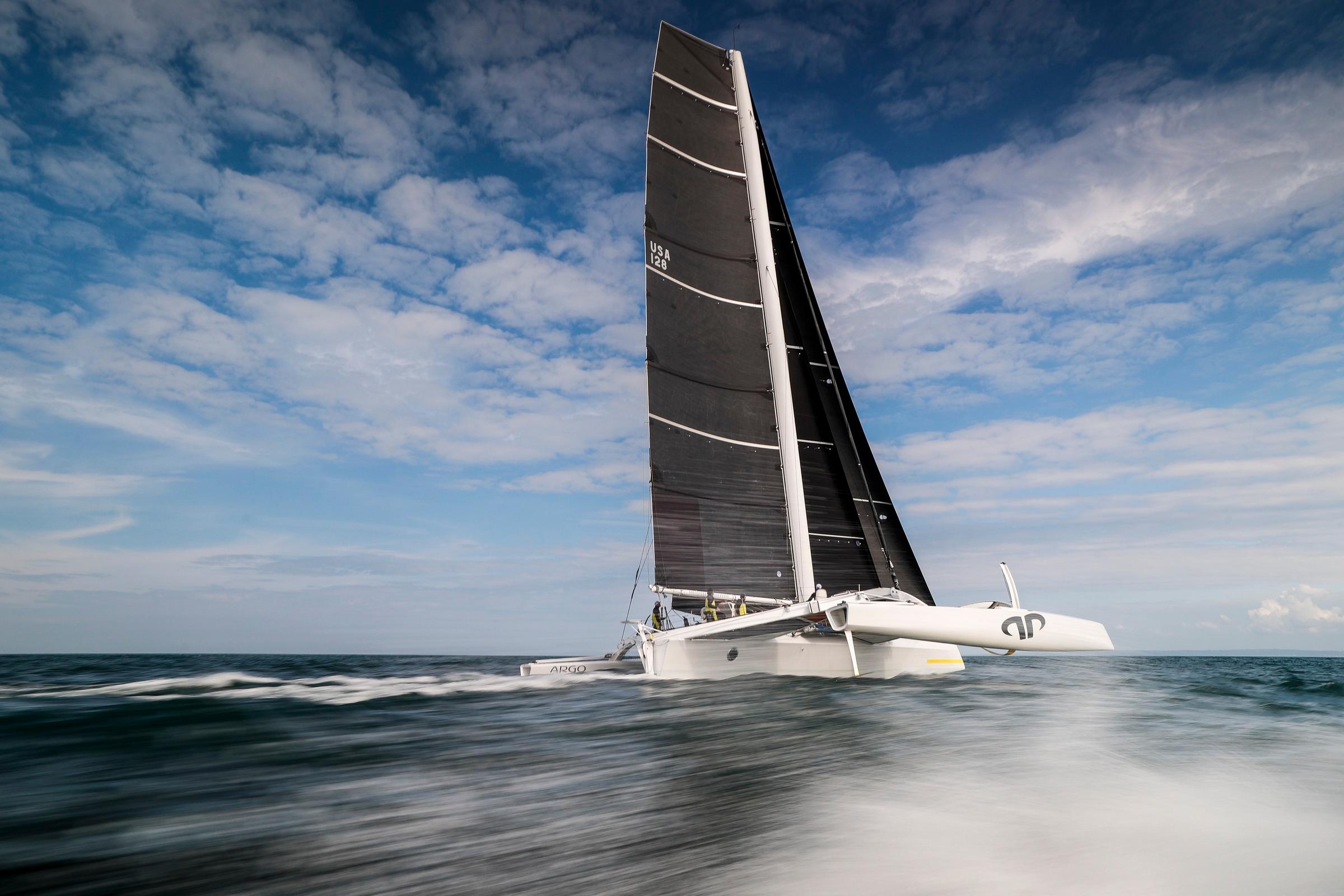 After shadowing
Zoulou for the majority of the race, bad luck and good tactics combined to enable Argo to speed past Zoulou in the last leg to Cherbourg-en-Cotentin © Paul Wyeth/pwpictures.com/RORC
After shadowing
Zoulou for the majority of the race, bad luck and good tactics combined to enable Argo to speed past Zoulou in the last leg to Cherbourg-en-Cotentin © Paul Wyeth/pwpictures.com/RORC
Gybing back towards Start Point the two got ‘out of sync’ and witnessing Zoulou getting stuck due south of Start Point, Argo simply sailed around them to the north.
“We saw there was wind to the west of them so we stayed in our band of wind,” explained Corning. In fact that wasn’t quite the only problem on board Zoulou, as French ace Loick Peyron explained: “Argo was quite far behind and we had a little issue – we hit something during the night and we didn't have any more port rudder; it was fishtailing when it was on the windward side and touched the water. So we lost a bit of a gauge there and then off the south of England there was a part that maybe we should have managed in a better way, but we didn't. I can't say that's easier when you are behind, but sometimes you can spot the fact that the leader is not going to be the leader anymore, because he's slow and the only thing you don't want to do is to follow them, so you have to think differently, do things differently…and that's what they did.”
Corning added: “We’d all been pretty glum, and it all seemed quite hopeless with 70 or 100 miles to go, but we had a few tricks up our sleeve and the local knowledge was there. But it was definitely a miracle. We have got to tip our hats to Zoulou. They were really sort of flawless and super unlucky, Part of racing is taking advantage of that. They sailed a great race. It feels nice for us, but obviously we feel terrible. It was their race so it's a bummer, but that's sport I guess.”
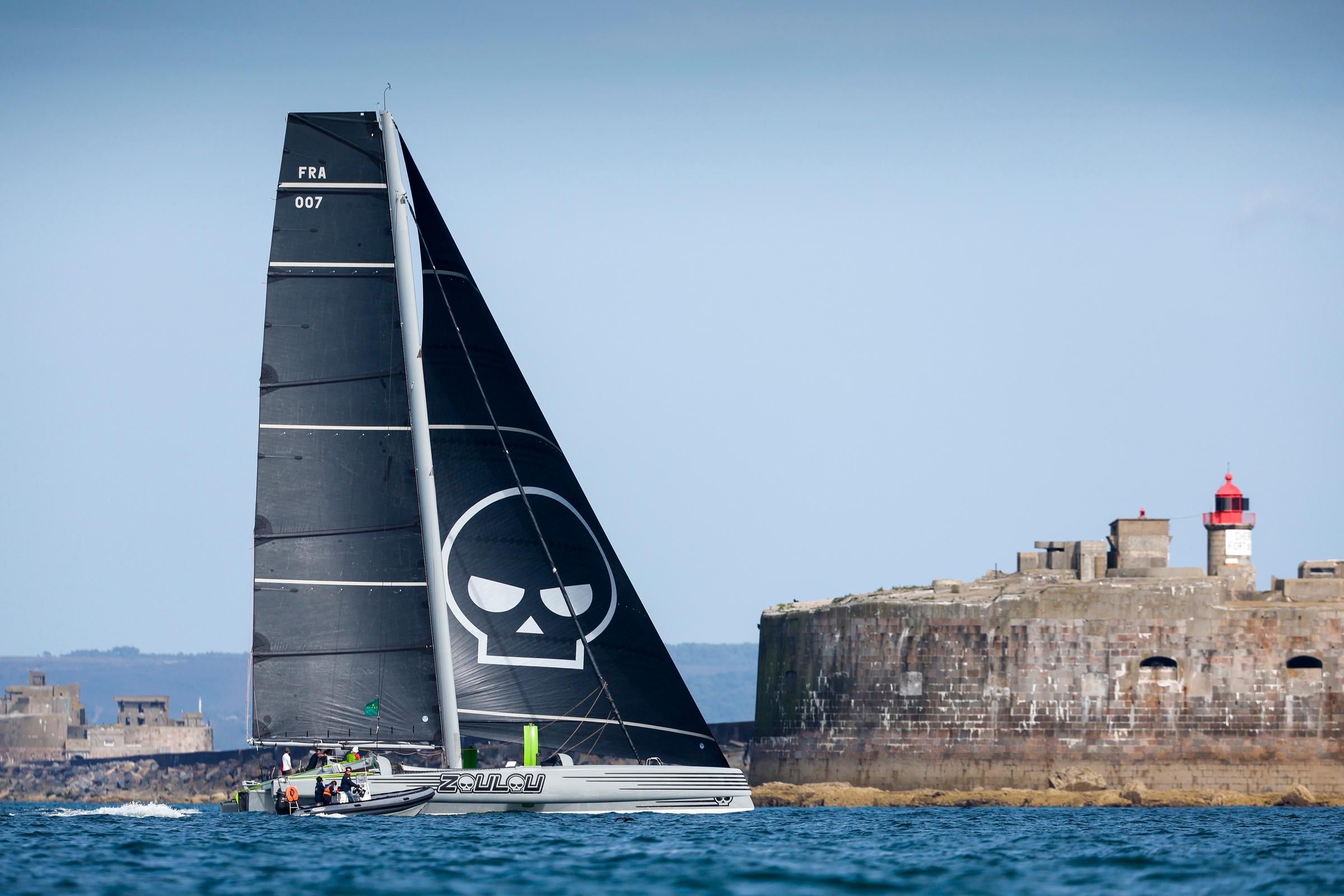 Zoulou arrives in Cherbourg-en-Cotentin, second MOD70 on the water to Argo by just 20 minutes © Paul Wyeth/pwpictures.com/RORC
Zoulou arrives in Cherbourg-en-Cotentin, second MOD70 on the water to Argo by just 20 minutes © Paul Wyeth/pwpictures.com/RORC
Unusually the routing showed that the MOD70s should pass close to Start Point and leave the Casquets TSS to starboard, thereby also avoiding the worst of the Alderney Race. “It was just for pressure and shift – every model agreed on that,” stated Corning.
From there Argo was able to keep her nose ahead and crossed the line at 16:29:36 with an elapsed time of 2 days 5 hours 9 minutes 36 seconds, with Zoulou following just over 20 minutes later.
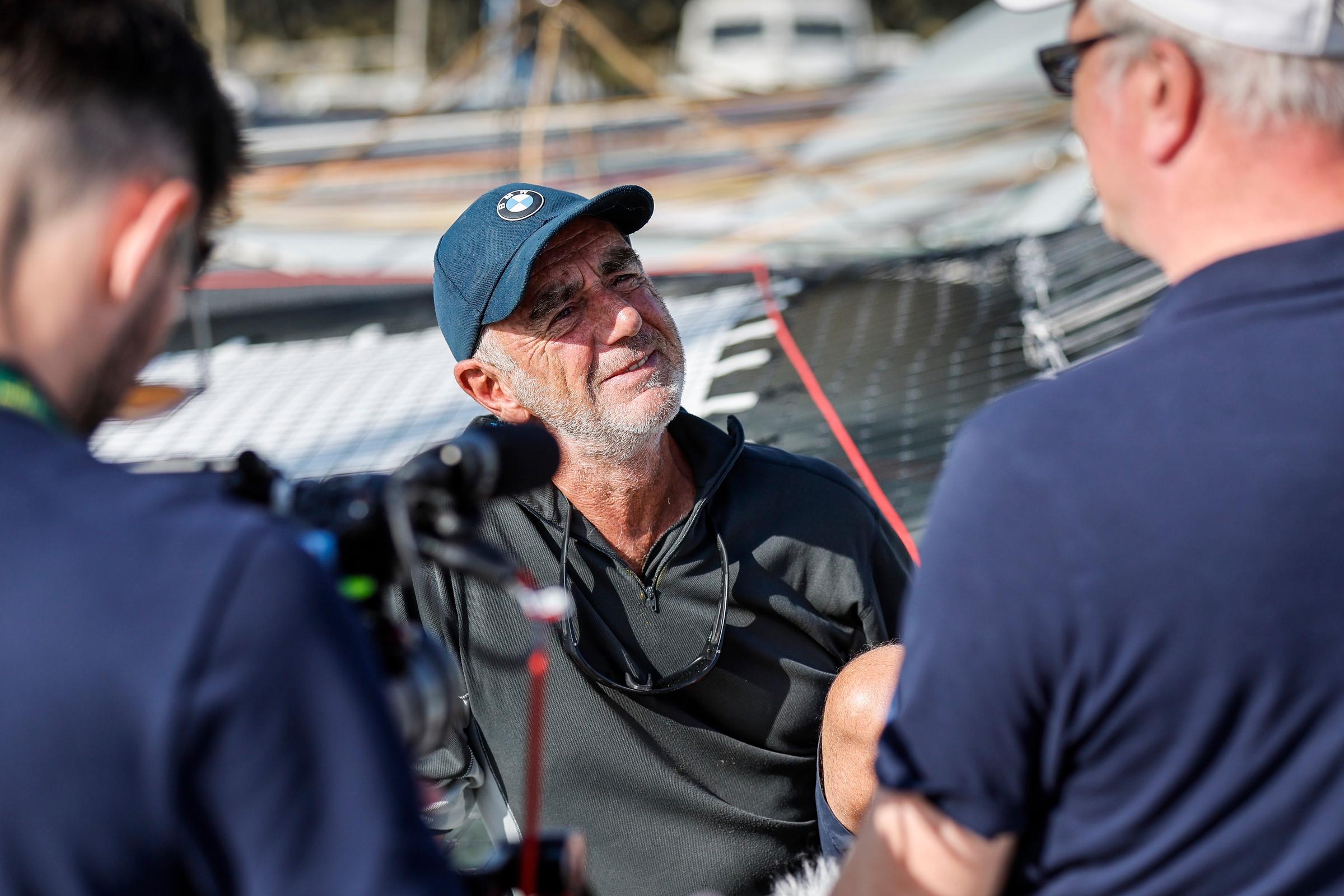 Loick Peyron is a Rolex Fastnet Race legend, having set two race records, in 1999 and 2011 © Paul Wyeth/pwpictures.com/RORC
Loick Peyron is a Rolex Fastnet Race legend, having set two race records, in 1999 and 2011 © Paul Wyeth/pwpictures.com/RORC
“That was a very good race with a nice crew, the perfect owner of a nice ship, I should say, the Zoulou,” commented Peyron, who has twice set race records for the Rolex Fastnet Race, once in 1999 on board his ORMA 60 Fujifilm and then on the mighty Banque Populaire V in 2011. “And a quite interesting [race], with flat water mainly, requiring no boots, no spray on the deck, nothing...not enough wind to finish, but an interesting one again.
“It was very impressive en route back to the Scilly Isles and crossing 90% of the fleet [going the opposite way].”
The multihull legend concluded: “The Fastnet is the Fastnet, like Mecca is Mecca, like the Vatican is the Vatican, for some obvious reasons. When you round that Rock, when you have the chance to sail around it, that is a privilege. That Rock is particularly symbolic.”
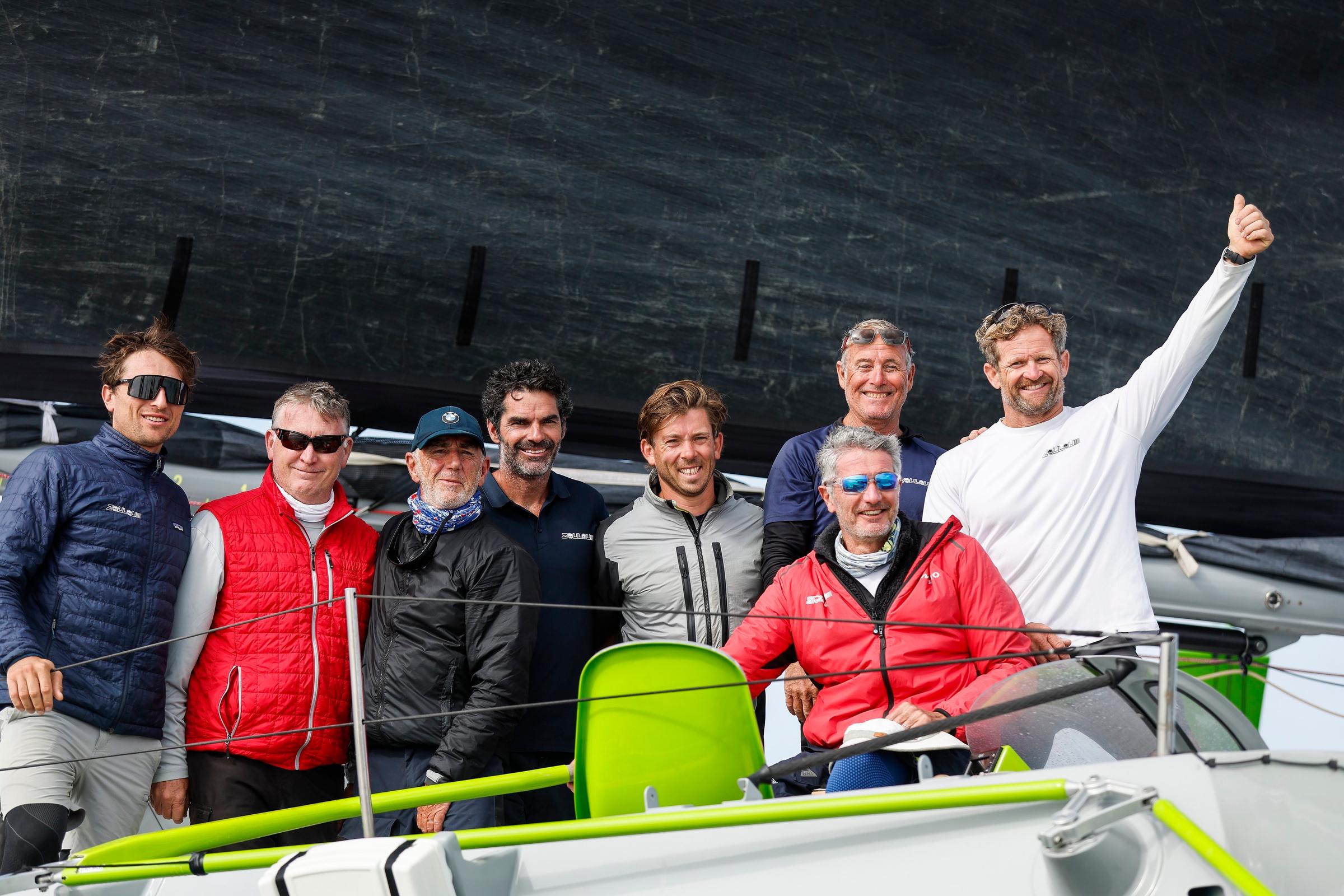 The Zoulou crew including owner Erik Maris (seated), and pros Loick Peyton (third from left) and Ned Collier Wakefield (fourth from right) © Paul Wyeth/pwpictures.com/RORC
The Zoulou crew including owner Erik Maris (seated), and pros Loick Peyton (third from left) and Ned Collier Wakefield (fourth from right) © Paul Wyeth/pwpictures.com/RORC
Inter Invest takes the Ocean Fifty honours
While little known outside of France, the Ocean Fiftys (ex-Multi 50s) are a trimaran class on the assent with nine boats competing in the centennial Rolex Fastnet Race, as part of their annual calendar. Despite being a speedy box rule class they enjoyed some of the closest racing across the fleet.
Highly surprising was just how competitive the doublehanded Ocean Fiftys demonstrated themselves to be in the Rolex Fastnet Race, with the leader reaching the Fastnet Rock on the transom of the MOD70 Argo and even the Ultims not fully shaking them off until they had passed Plymouth.
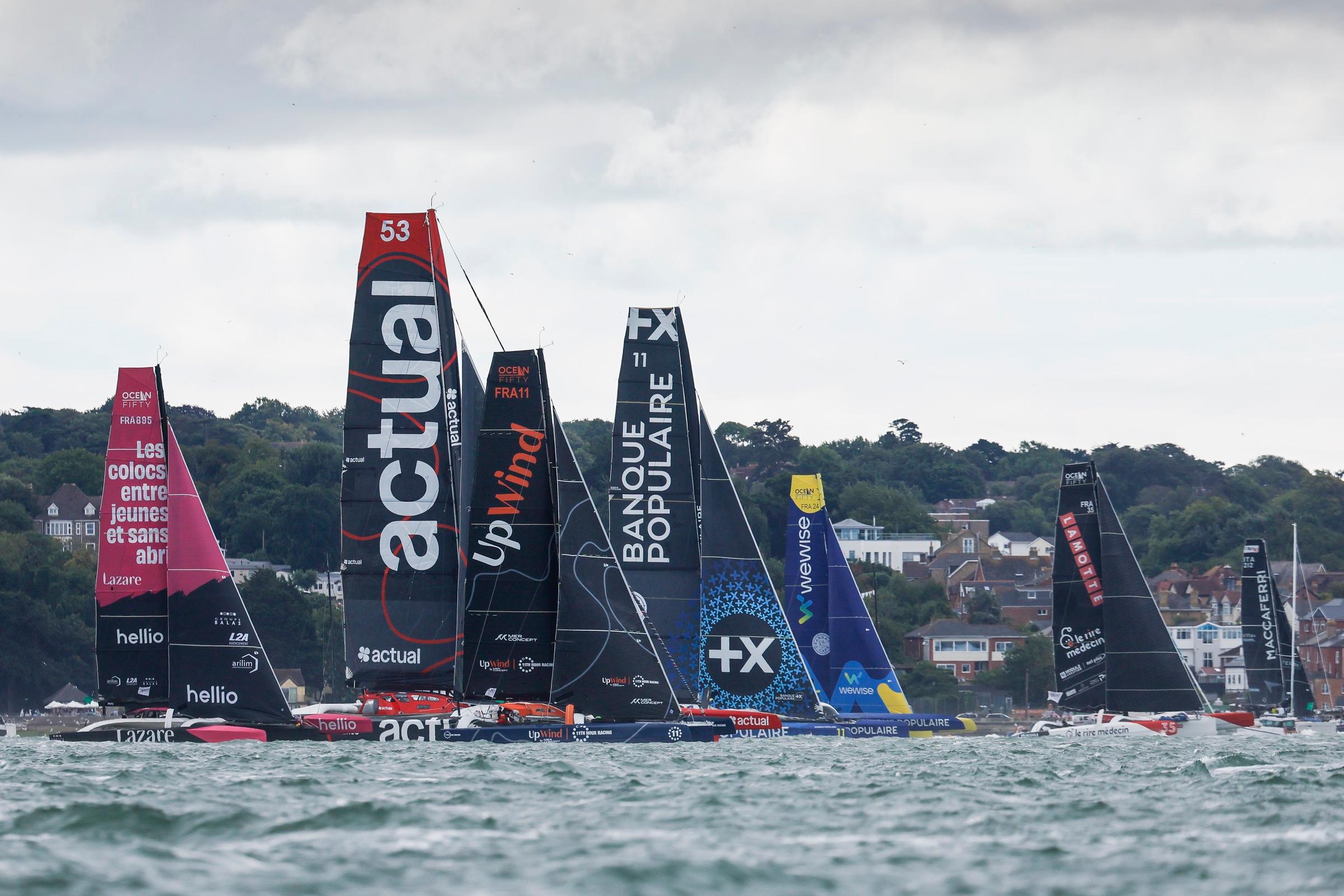 Nine Ocean Fiftys started from Cowes, the race forming part of their annual calendar in 2025 © Paul Wyeth/pwpictures.com/RORC
Nine Ocean Fiftys started from Cowes, the race forming part of their annual calendar in 2025 © Paul Wyeth/pwpictures.com/RORC
Exiting the Solent Matthieu Perraut and Jean-Baptiste Gellée on the Neyhousser-designed Inter Invest led Erwan le Roux and Audrey Ogereau on the VPLP-penned Koesio out of the Solent alongside Banque Populaire, the mighty Ultim literally twice their length. That evening they passed Portland Bill, hanging on to the coattails of Actual Ultim 4, with Koesio now out in front heading deep into Lyme Bay. Inter Invest timed their tack back out of Lyme Bay better than the others, overtaking Koesio, but the whole class remained tightly grouped.
By Start Point Koesio was back in front, ahead of MOD70 Argo with Lazare second. Lizard-bound, Ultims Banque Populaire and Sodebo slowly rolled past, with Tanguy le Turquais and Erwan Le Draoulec on the VPLP-designed Lazare, Inter Invest and Viabilis racing three abreast. They passed the Lizard on Saturday just after 22:00, the frontrunners still hanging on to Argo. 01:00 Sunday found Koesio still ahead, leading the front four Ocean Fiftys up the west side of the Land's End TSS.
The going was slow as the wind turned flukey in the mid-Celtic Sea on Monday morning. Here Inter Invest made a better roll of the dice to nose ahead of Lazare, back up with Argo, onto whom they were somehow able to hang all the way to the Fastnet Rock. Here Inter Invest rounded first at 19:58:17 on Sunday night, 15 minutes ahead of Lazare, with Koesio an additional six minutes later with all nine Ocean Fiftys rounding within four hours.
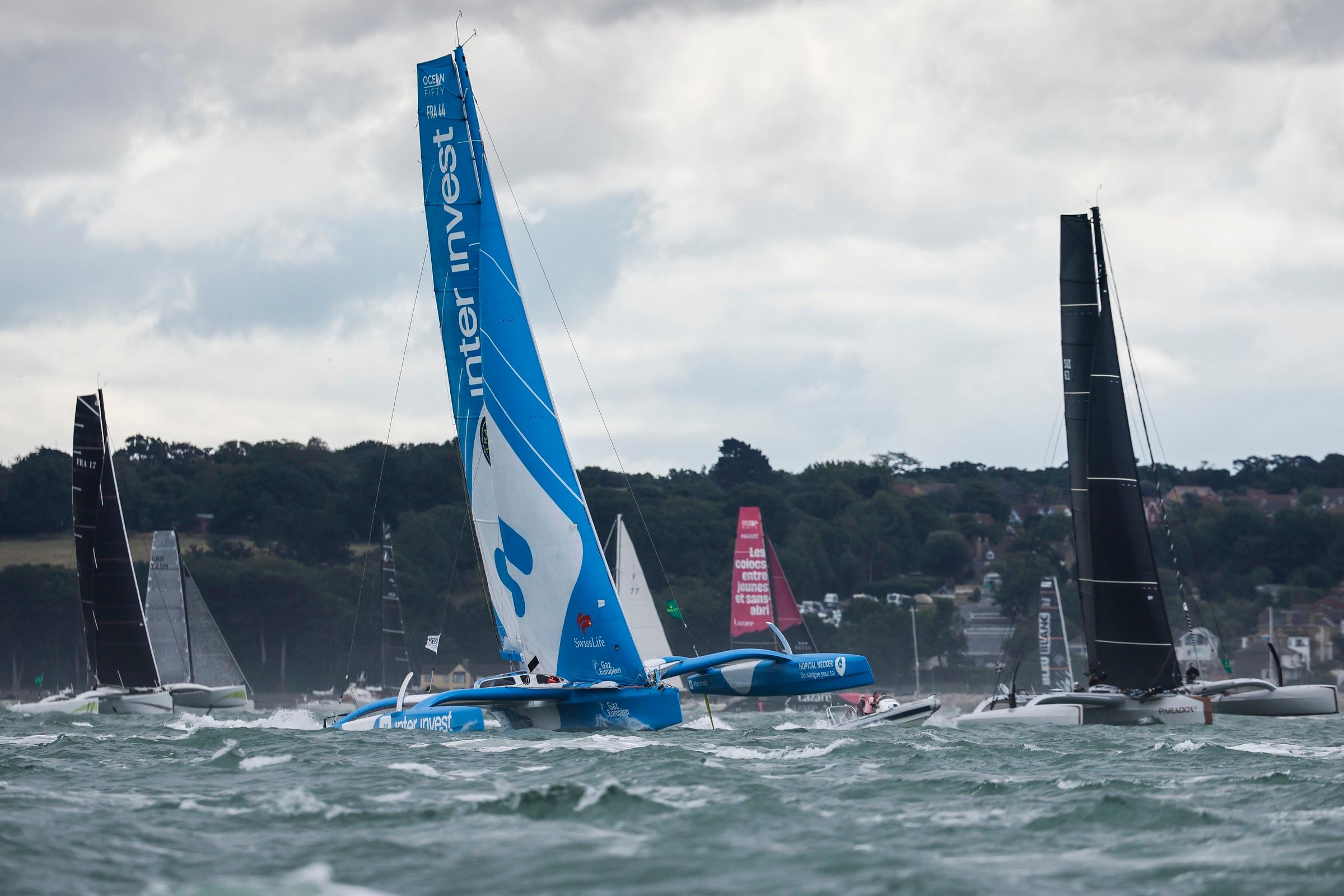 From Cowes to the Fastnet Rock, it was a closely fought contest between the Ocean Fiftys, after which the blue-hulled Inter Invest pulled out the stops to lead all the way to the finish © Paul Wyeth/pwpictures.com/RORC
From Cowes to the Fastnet Rock, it was a closely fought contest between the Ocean Fiftys, after which the blue-hulled Inter Invest pulled out the stops to lead all the way to the finish © Paul Wyeth/pwpictures.com/RORC
Early into their return journey, Inter Invest put in a hard gybe to port immediately after the Fastnet TSS. Possibly their winning move, this tactic meant that when she tacked south she was in better pressure and making two knots more than the boats in the west like Thibault Vauchel-Camus and Damien Seguin’s Neyhousser-designed Solidaire en Peloton.
Heading east past the south side of the TSS to the south of the Scilly Isles, Inter Invest was now firmly out in front, and led the Ocean Fiftys tight into the Lizard. Like the MOD70s ahead of them, their routing took them around the north side of the Casquets TSS en route to Cherbourg, although Solidaire en Peloton opted to split south of it.
Inter Invest crossed the Cherbourg-en-Cotentin finish line as dusk was settling at 19:58:13 on Monday 28 July, followed by Koesio 31 minutes 16 seconds later and Viabilis Oceans a further 20 minutes 29 seconds back. 2023 Rolex Fastnet Race winner Luke Berry and Antoine Joubert on Ocean Fifty Le Rirce Medecin-La Motte just missed the podium by 2 minutes 43 seconds. The top seven Ocean Fiftys arrived within two hours.
For Inter Invest’s crew it was their first victory since Matthieu Perraut teamed up with Sebastien Rogues’ 2024-winning team, using Rogues’ boat at the beginning of the year. It was also the first time her crew had competed in the Rolex Fastnet Race and their first major Ocean Fifty victory.
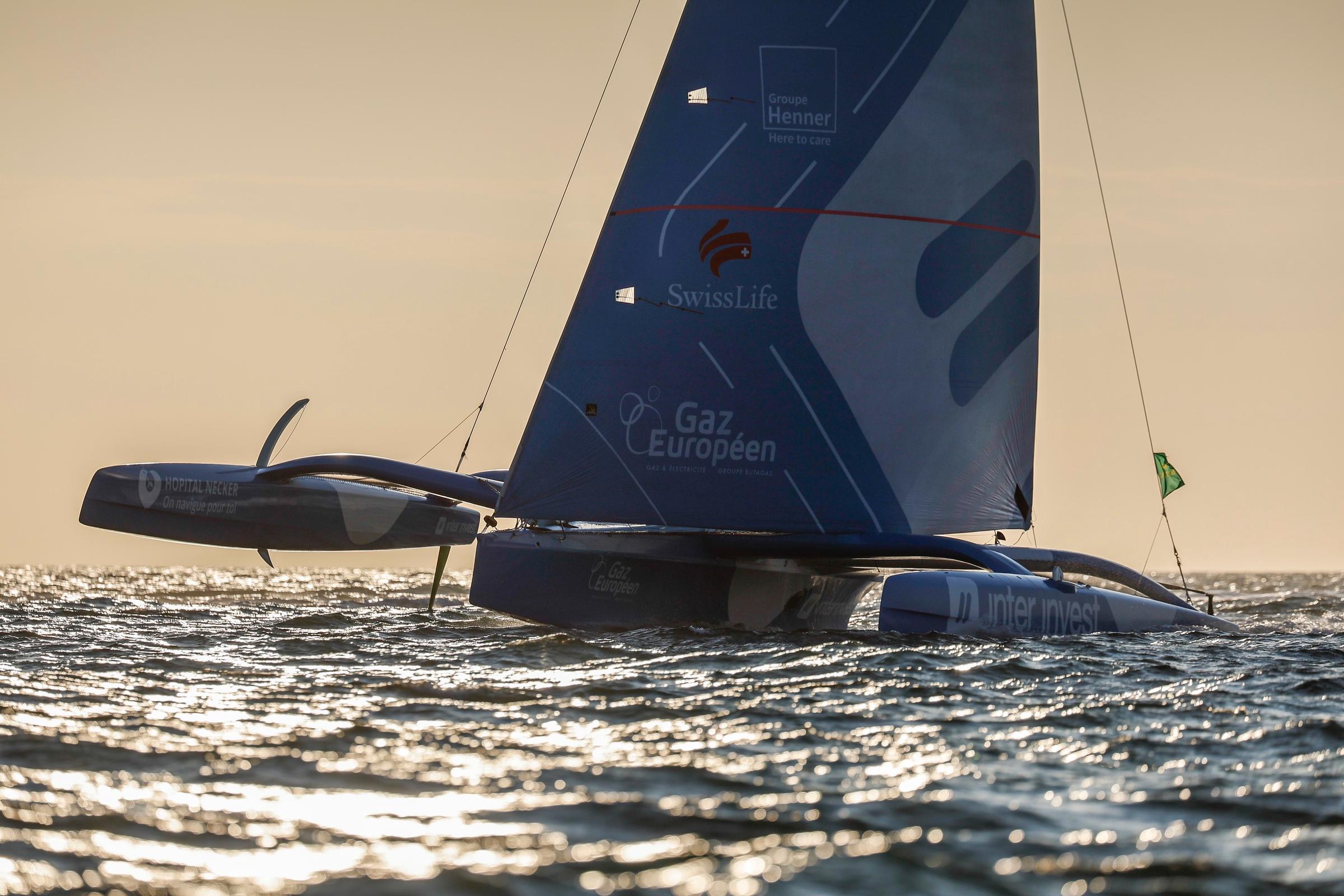 Inter Invest cruises into the finish in Cherbourg-en-Cotentin to win the Ocean Fifty class © Paul Wyeth/pwpictures.com/RORC
Inter Invest cruises into the finish in Cherbourg-en-Cotentin to win the Ocean Fifty class © Paul Wyeth/pwpictures.com/RORC
Perraut paid tribute to their steed. “It was built by a great team. We are lucky to have a boat that is so well prepared. It's crazy racing these Ocean Fiftys – they are really great boats.” He explained of their attitude on board: “We took care of ourselves. Both of us tried to sleep well and to be well focussed until the end. We left in excellent conditions and sailed quite well. From the outset, we were in a good position.”
Upwind out to the Fastnet Rock or downwind coming back, Gellée said they had kept a keen eye on the tracker to choose the optimum places to manoeuvre. “After the Scilly Isles we worked a lot on board to choose the best angles and wind.”
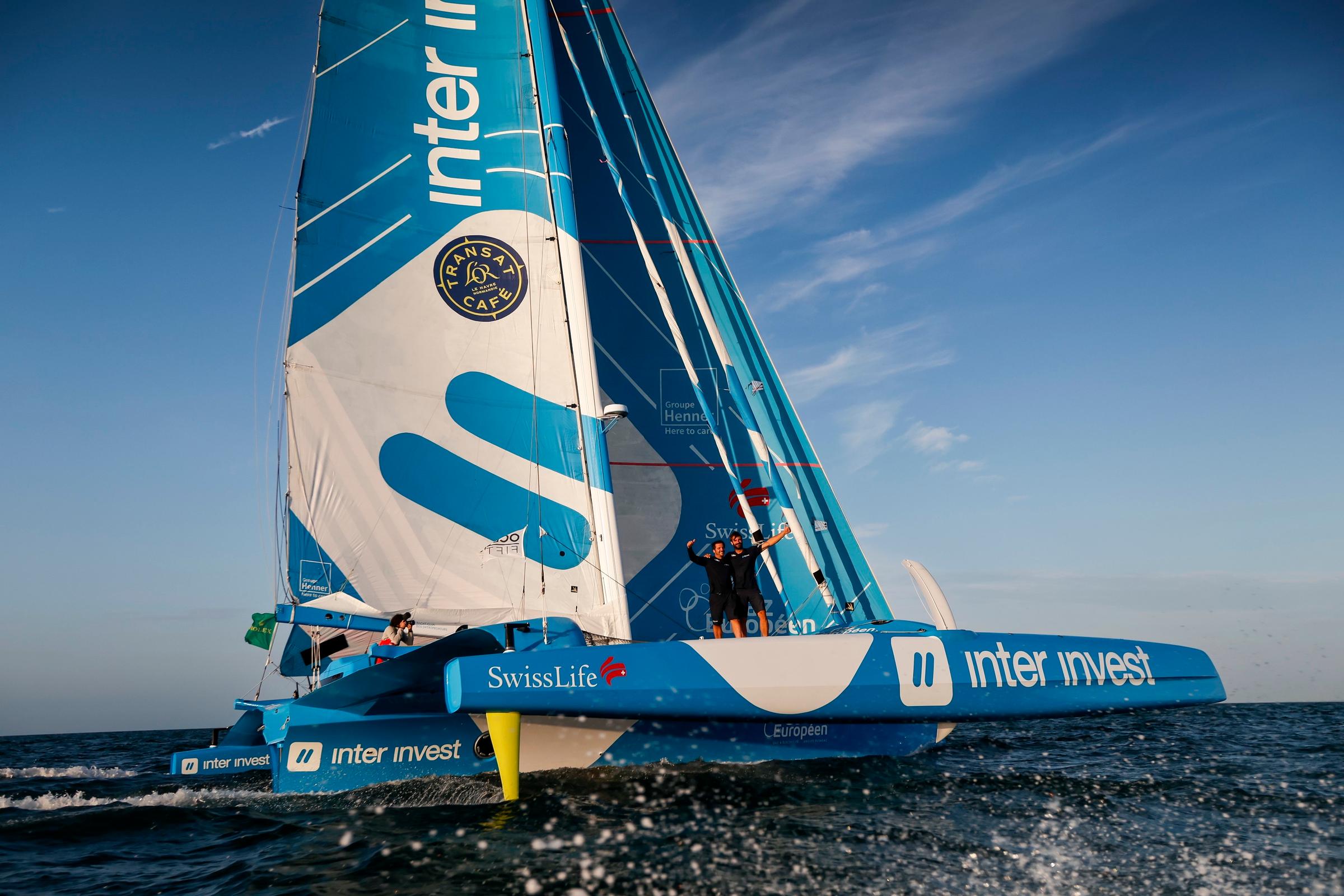 Inter Invest is sailed doublehanded by Mathieu Perraut and Jean-Baptiste Gellée © Paul Wyeth/pwpictures.com/RORC
Inter Invest is sailed doublehanded by Mathieu Perraut and Jean-Baptiste Gellée © Paul Wyeth/pwpictures.com/RORC
Just missing the podium Luke Berry felt he and Antoine Joubert had done well in the circumstances. “Nine Ocean Fiftys on the Rolex Fastnet Race – and we had quite a good fight with the Ultims because there wasn’t much wind and it was very shifty. They only overtook us at Start Point. Then upwind was a bit difficult for us because we're not as fast – Inter Invest and Koesio are a bit stiffer and are very, very fast. They are from 2023 and their hulls are a bit thinner. But downwind it's not as bad, so as soon as we got around the Rock, we accelerated and we managed to catch up with them because it slowed down from the front. Upwind we were making about 18 knots but downwind, we were bombing along, around 27-28 knots.
“To miss the podium by a couple of minutes – it could have been worse.”
